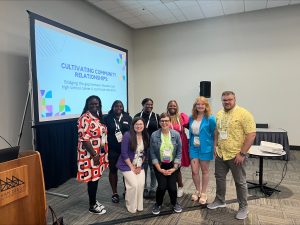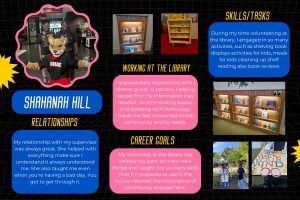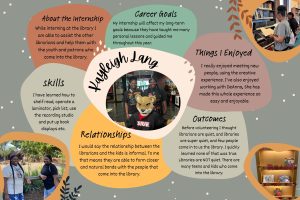The DLCTE Toolkit has three major sections: program components, documents and forms, and additional resources. The program components will guide librarians through major pieces of our program including being a workplace partner and/or managing a program that places CTE students in library settings for their work-based learning. Within documents and forms, you will see downloadable templates that you can edit to fit your needs. Additional resources include CTE career guides and a links to similar programs organized by libraries. The DCLTE Toolkit by the IMLS Diverse Library Career Training & Education Program at Southern Illinois University Edwardsville is licensed under a Creative Commons Attribution-NonCommercial-ShareAlike 4.0 International License.
Learn the CTE Lifecycle
It can be a challenge to figure out the timeline for recruitment into a work-based learning program. Typically, these programs are built for high school seniors; they can be as short as a semester or may span their entire senior year. Learn about the expectations of CTE at your local high school and the process to get the students ready. Keep the following tips in mind as you plan for recruitment.
When to Recruit
Start early, recruit often! Work backwards to capture students when they’re making decisions about their senior year, i.e., recruit juniors (maybe even sophomores or freshman!). While work-based learning programs happen during the senior year of high school, students often register for classes and programs during their junior year or even earlier. You’ll need to work with the CTE teacher and administrators to see when and how you could meet with students interested in CTE to learn about working in a library.
How to Recruit
Many CTE programs will host a Recruitment Fair at the high school, typically in the spring for juniors to come and meet representatives from workplace partners. This is a chance to share information about your workplace and more importantly, your profession. Librarian stereotypes remain strong, so you will likely encounter high school students (and teachers and parents!) who think the work involves shushing, working in a quiet space, and reading books. Come prepared to answer questions like:
- What does a librarian do? What’s a typical day?
- Why do you find your job rewarding?
- What kind of work would I do as a CTE student at the library?
- What kind of skills would I gain by working in a library?
Next Steps: Mock Interviews
Once you have students interested in choosing your organization as their workplace, conduct a mock interview. If you have more students interested than positions available, the mock interviews will help you decide who to offer positions to. Even if you have only one student interested, it is important to interview them because you are helping to create an experience that they can take with them when they graduate high school. This mock interview experience will help prepare them for when they are applying for jobs. Check out our Mock Interview Questions in the Documents and Forms Section.
After a student(s) accepts an offer to work at your library, you should schedule a day and time for orientation. This is an opportunity to sign forms to get paid, introducing students to people at the library, and explaining expectations. We created a checklist to structure orientation and make sure we covered everything needed to get the students working.
Orientation can help prepare students for the CTE experience in the school year ahead. If you have any experiences outside of the weekly work schedule planned, giving an overview of the calendar of events would be helpful to get everyone’s calendars aligned and to set expectation for attendance. Other experiences could include curriculum lessons, visits to other types of libraries, or attending a library conference. If mentors are available for students during their library CTE program, this orientation period will be a good opportunity to introduce mentors to students and library site supervisors (if mentors are from outside of the workplace partner).
Onboarding will cover library workplace policies and procedures. Some libraries will already have onboarding procedures in place for volunteers that can be adapted for new CTE students. Others can cater their existing employee onboarding plan to a new CTE program, making any necessary adjustments for how the CTE students might log their worktime and however their duties may differ from other library workers.
CTE students’ responsibilities and duties at a host site can vary across libraries. We found success at St. Louis Public Library, where they have an established volunteer program. Our CTE students operated as Youth Services volunteers (but were paid through an IMLS grant).
Their Youth Services Volunteer responsibilities included:
- putting together take-home craft kits
- curating children’s book displays
- pulling items for daily pick lists
- shelf reading
- helping with the community lunch program
- writing youth book reviews for Reader Advisory
You may decide to give your CTE students more responsibilities. You may train them on integrated library system software, and they could perform circulation duties. They can work as pages/shelvers if you train them to use your classification system. How the students’ positions are funded and whether they are hired as library staff could affect what responsibilities they’re allowed if your employees have an agreement through union representation.
Why Do we Need Mentors?
The DLCTE program utilizes existing strategies and theories within the workforce pipeline model for students to create and maintain interest in the library profession. Pipeline “leaks” will result if students lose interest along their career path. The ongoing mentorship goal that our program model provides will help stop the “leak” of students on a library services career path. Our mentors are library professionals that we believe will offer guidance, support, and encouragement to help their mentee reach their full potential.
Who Are the Mentors?
As we set out to recruit two cohorts of five high school seniors from diverse and underrepresented backgrounds, we also set out to find five library professionals who have demonstrated expertise with the necessary skills, experience, and knowledge to recognize significant challenges and impact broad change to the student cohorts and the field. We found five capable mentors internally at Lovejoy Library but we also explored possibilities of mentors in local public libraries.
What Are Some of Our Mentors’ Duties?
- Teaching Curriculum Lessons
- Advising Students through early librarianship
- Checking In With Students and Assessing Mental and Physical Wellbeing
- Ensuring that students feel safe and supported at the partner workplace
- Assist mentee with timesheets and other paperwork submissions
- Chaperoning students during travel to conferences and other field trips
Best Practices in Mentorship
- Set up more than one channel for communication. Communication has been one of the more difficult aspects of mentorship. Some students were unable to receive e-mails as their inbox had reached capacity. Others had changes in their ability to receive text messages.
- Verify Electronic Communication when Meeting in Person. If you are able to meet with your mentee in person, take a moment to confirm that communication comes through. Make sure that the student is able to retrieve e-mails and/or text messages before leaving.
- Don’t let program lead be a mentor. A Program Lead will be the one to make any difficult decisions during the CTE program, including placing students on probation or removing a student from the program. Separating these administrative duties from the role of mentor will be easier for everyone and will allow the project lead to make the best decisions for the program.
Supervising students in a CTE program will certainly differ from supervision of everyday library employees. At the very least, a supervisor within the library workplace will need to communicate and report to a CTE coordinator from a student’s high school. If an outside mentor is in place for the student, the mentor should also be made aware of any supervisory communications, including disciplinary actions, work-related feedback, well-being concerns, and any questions from the student.
Student supervision can be a challenge for library workplace partners, so it will be helpful to include mentors and CTE coordinators to ensure any student’s success in the program. Attendance and punctuality are common issues with CTE programs, especially for programs that do not require students to report to school on days that they perform workplace duties. Workplace supervisors can work with students and mentors to establish and adhere to a schedule that works for the student and workplace.
The curriculum for this program focuses on training culturally competent and socially responsible library and information science professionals. It provides students with information about each library mentor’s field of expertise and a foundational education in library and information science. This curriculum was designed to build skills necessary to navigate the information services workforce, as well as provide them with the tools to have constructive conversations on diversity, and inclusion as it relates to the library profession.
Students also receive instruction on each library mentor’s field of expertise that provides them with a foundational education in library and information science. The curriculum emphasizes the following: Internship Competencies and Communication, Introduction to Libraries, and Careers in Library and Information Services.
Example Curriculum Schedule
- Part 1: Competencies & Communication
-
- Unit 1: Orientation & Internship Competencies (delivered in November)
-
-
- Topics include: Meet & greet with library mentors, financial literacies, and job specific trainings
-
-
- Unit 2: Communication & Teamwork (delivered in December)
-
-
- Topics include: Library tool training (Teams, Zotero, project management and project management tools) and working in a team, division of work, and conflict resolution
-
- Part 2: All About Libraries
-
- Unit 3: Introduction to libraries (delivered in February)
-
-
- Topics include: A brief overview of how libraries serve communities and universities, and leading and managing in libraries
-
-
- Unit 4: Reference and Information Literacy in Libraries (delivered in March)
-
-
- Topics include: Reference services, serving diverse population, teaching in libraries, and information literacy
-
-
- Unit 5: Circulation, Cataloging, & Access (delivered in April)
-
-
- Topics Include: Circulation services & resource sharing, information organizations, organization of information, collection development and management
-
-
- Unit 6: Technology Services and Digital Libraries (delivered in May)
-
-
- Topics include: The digital divide, engagement, data and society, exhibits
-
- Part 3: ALA Summer Institute
-
- Unit 7: Careers in Library & Information Services (delivered in June)
-
-
- Topics include: Scholarships, fellowships, jobs, concentrations, LIS schools
-
Example Curriculum Slide Decks
Unit 1 Internship Competencies_DLCTE
What We Did
We designed our program to include an event at the end of the program year that allowed students the opportunity to reflect on their experience in the program and to continue to explore librarianship with their mentors. We called this three-day event Summer Institute. Summer Institute evolved over the three cohorts due to both student needs and things we learned. Our first cohort ended with one student, so Summer Institute was incorporated into our trip to the American Library Association (ALA) Conference in Washington, DC and included a visit and tour of the Library of Congress. Cohort 2 provided us an opportunity to build deeper mentee/mentor relationships by bringing the students to Southern Illinois University Edwardsville (SIUE) to immerse them in the day-to-day activities of Lovejoy Library and the campus. For cohort 3, we built an even more successful Summer Institute by again bringing the students to the SIUE campus, but also scheduling visits and tours to the Library and Teacher Resource Center at the St. Louis Zoo, the Peter H. Raven Library at the Missouri Botanical Garden, and the Central Library, a branch of the St. Louis Public Library built in 1912 with funds from Andrew Carnegie. Students also spent time creating physical or digital posters that reflected their experience in the DLCTE program. Students presented their posters to family, friends, teachers, workplace supervisors and staff, and the DLCTE team at a celebratory dinner culminating Summer Institute.
Here are posters students created at the 2024 Summer Institute:
What You Can Do
By cohort 3, we had finally figured out how to create a Summer Institute that best-supported student interests. The students enjoyed visiting and learning more about other types of libraries, but they also enjoyed learning about student resources at SIUE. Cohort 3 made us realize that there is an opportunity for us to introduce students to librarianship and SIUE. Since our grant is ending, we are considering how we can continue this work on a smaller scale. One idea is to invite students from diverse and underrepresented minority groups to campus for an event like Summer Institute but schedule it in the fall close to an SIUE Preview Day. During this event, students would learn about careers in librarianship and SIUE and tour other libraries. Although we are considering a multi-day event, a program like this could be scheduled for one day. Students have been consistently in awe of libraries and the work we are doing in them. Invite students to your library and share with them the work you are doing. And if you happen to be an academic library, introduce them to your campus. You might recruit new students and create library advocates, or even librarians.
What We Did
Our program was designed to include attendance at a library conference, specifically the American Library Association (ALA) Conference. However, when a cohort 2 student expressed strong reservations about flying to Chicago for the ALA Conference in 2023, we knew that the San Diego location of the 2024 ALA Conference could be challenging for cohort 3 students with travel concerns. We were pleasantly surprised when in March 2023, the Illinois Library Association (ILA) Board DEI Subcommittee offered to cover the registration fees for our cohort 3 students to the 2023 ILA Conference in Springfield. This location was much more feasible than San Diego and would allow the students to attend a library conference much closer to home. Three students accompanied by two grant team members traveled to the ILA Conference in October 2023 via Amtrak. The ILA Board also invited the students to the Youth Services Forum Author Breakfast which featured author and illustrator Jason Chin. As it turned out, cohort 3 students warmed up to traveling to San Diego and attended both the ILA Conference and the ALA Conference during their cohort.

Front row left to right: Lora Del Rio, Tammie Busch
Back row left to right: Debra Casimere, Shahanah Hill, Kayleigh Lang, DeAnna Anderson, Elizabeth Kamper, Jacob Del Rio
What You Can Do
We know from the feedback we received from our students that attendance at a library conference is a rewarding experience. Conferences provide an opportunity to see all aspects of librarianship, from the distinct types of libraries we work in to the varying types of work we do, so investing in this one component alone can significantly impact a student. We also know that state library associations are an avenue to request and receive support. If you are looking for a way to help introduce underrepresented students to librarianship that does not involve a long-term time commitment, consider taking them to a library conference. This small investment of time and money can significantly impact students.


